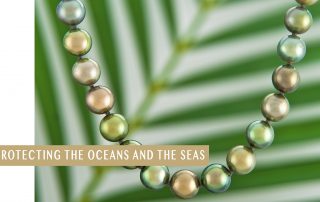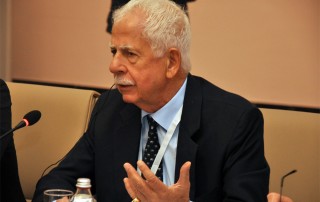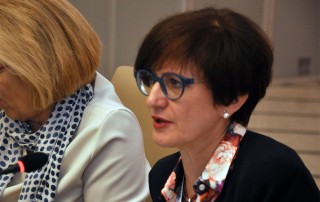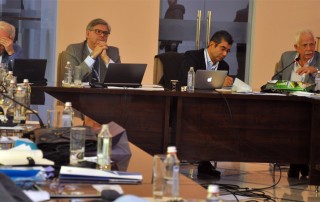About admin007
This author has not yet filled in any details.So far admin007 has created 188 blog entries.
CIBJO releases Pearl Commission Special Report, focuses on industry’s commitment to marine sustainability
September 26, 2018
With fewer than three weeks to go to the opening of the 2018 CIBJO Congress in Bogotá, Colombia, on October 15, 2018, the seventh of the CIBJO commissions’ Special Reports has been released. Prepared by the CIBJO Pearl Commission, headed by Kenneth Scarratt, it focuses on the growing commitment of pearl farmers from around the world to set the golden standard for sustainability in a marine environment.
“Mankind’s impact on the earth’s environment is not simply related to saving the elephants, lions and the rhinoceros, or wild orchids, while these have great urgency. But they are no greater than the significant issues surrounding how we control the massive volume of rubbish generated globally that enters our oceans and seas,” wrote Mr. Scarratt.
Surveying a list of ongoing projects from the Philippines to Australia, the Indonesian archipelago to West Papua, and Fiji to Bahrain, Mr. Scarratt describes a community whose long-term livelihood is dependent on its ability to maintain a pristine ocean environment, and to provide economic opportunity to the far-flung indigenous communities where pearling is carried out.
“Pearl farming has often been described as ecological aquaculture,” notes Mr. Scarratt, quoting the Blue Pledge, a new initiative that aims to unite pearl farmers who actionably seek to contribute to the health of the oceans and the global climate. “Pearl oysters are filter feeders that require pristine water conditions in order to produce high-quality pearls. They are also recognised as an indicator species, meaning that any decline in water quality has a direct impact on oyster health, pearl quality, and oyster mortality.”
“Thus, while the world around us appears to be desperately struggling with man’s ineptitudes, let us take comfort in the fact that our pearling community can stand proudly as shining examples to the rest of humanity,” Mr. Scarratt writes.
To download a full copy of the CIBJO Pearl Commission’s special report, PLEASE CLICK HERE.
CIBJO releases Gemmological Commission Special Report, surveys gem labs about synthetic and treated diamond reports
September 19, 2018
With fewer than four weeks to go to the opening of the 2018 CIBJO Congress in Bogotá, Colombia, on October 15, 2018, the sixth of the CIBJO commissions’ Special Reports has been released. Prepared by the CIBJO Gemmological Commission, headed by Hanco Zwaan, it reveals the results of a survey of 23 gemmological laboratories from around the world, about whether and how they report on synthetic and treated diamonds.
“The survey provided a clear picture of the similarities and differences on the reports issued by the various laboratories, and perhaps also suggested the requirements and preferences of different markets around the globe,” wrote Mr. Zwaan. “Overall the nomenclature used by laboratories is clear about the nature of the stones described, but there are inconsistencies with regard to the precise terms used, and whether or not grading of synthetic and/or treated stones is permitted.”
The special report also provides details about a document prepared by the Gemmological Commission, which it intends will come to serve as a reference point for the industry in the way that it deals with commercial colour terms such as “pigeon blood red” and “royal blue.” Other subjects discussed include how professional opinions can or should be presented separately on laboratory reports, and the necessary standards for governing the use of varietal names for different gemstones.
To download a full copy of the CIBJO Gemmological Commission’s special report, PLEASE CLICK HERE.
Sector A discusses use of technology, benefit of guides and Blue Books’ future
ABOVE: Roland Nafule, President of Sector A, the division within CIBJO that deals with gem materials.
OCTOBER 28, 2016
Sector A President Roland Naftule opened the meeting by thanking CIBJO President Gaetano Cavalieri and all the Commission Presidents for their hard work in the period that has passed since the 2015 CIBJO Congress in Salvador, Brazil, in May 2015.
He also spoke about CIBJO’s intended creation of a ‘My CIBJO’ section on its website, where documents will be posted to enable members to easily find information relating to all of CIBJO members’ discussions and meetings.
Mr. Naftule spoke about the Pearl Guide developed by the Pearl Commission under the presidency of Ken Scarratt that has a tremendous amount of information that could not be added to the Blue Books. The provision of such guides will greatly assist the wider jewellery industry around the world.
He also mentioned a proposal to create an Opal Guide presented by Andrew Cody of behalf of the Australian industry, and it was agreed to proceed within the framework of Sector A. This was conditioned on the inclusion of opals produced in all countries of the world.
The meeting also held a brief discussion on whether, with development of guides for different gemstones, the Blue Books should be limited to international trade rules. Other important information could be provided through the new guides. This, it was said, may simply the task of translating the Blue into languages other than English.
Nickel, conflict minerals and FTC Guides top Precious Metals Commission agenda
ABOVE: Karina Ratzlaff , Vice President of the Precious Metals Commission, who chaired the body’s meeting at the 2016 CIBJO Congress .
OCTOBER 28, 2016
The Precious Metals Commission featured a discussion on changes to regulations regarding use of nickel, particularly the EN1811:2011 standard which had caused concerns to the trade. CIBJO has lobbied for changes to the 2011 standard which came into force in January 2016. The Assay Office in Birmingham represented CIBJO in two international conferences on the issue over the past year since the last CIBJO Congress.
These included a Nickel Institute Conference in Brussels in June 2015 which proposed a clearer definition of direct and prolonged contact with the skin. There was a North American workshop on NACD (Nickel Allergic Contact Dermatitis) which is a growing problem in North America where there is no enforceable nick regulation, the commission members were told.
Moving on to the issue of conflict materials and the effect of the U.S. Dodd Frank Act, controlling sources of tungsten, gold, tin and tantalum to prevent illegitimate sources in the Congo, the meeting heard that the European Union (EU) is still in the process of discussing similar legislation.
A voluntary regime was proposed by the EU, but there is currently an impasse because members of the European Parliament called for radical changes last year, but the Dutch Presidency of the EU wants to avoid the huge administrative burden that it would cause to 800,000 companies.
No legislation has been proposed yet and the outcome is still unclear, Commission Vice-President Karina Ratzlaff explained. The new regulation will apply to tungsten, gold, tin and tantalum, and the conflict and high-risk areas would not be limited just to Congo, she said.
In addition, due diligence required would need to comply with Organisation for Economic Cooperation and Development (OECD) standards. Smelters, refiners and large importers would be required to conduct due diligence. There would be no direct obligations for manufacturers, but they will be encouraged to report who their suppliers are.
Cecilia Gardner, the General Counsel for the Jewelers Vigilance Committee in the United States, gave the meeting a review of the progress in talks with the U.S. Federal Trade Commission which serves to protect American consumers. The FTC is revising its guides, and precious metals is of great concern to them, particularly relating to thickness of metal applications/coatings and karat quality mineral thresholds in alloys.
You cannot call a jewellery item made of an alloy containing gold as gold unless it contains at least 10 karats of gold, Ms. Gardner said. Consequently, some jewellers are creating trade names for such alloys because they cannot call them gold, and they are not allowed to tell consumers what is in the alloy under current guidelines. The JVC, however, believes that this is information that consumers need and jewellers should be allowed to tell consumers about the content.
The JVC feels the way to distinguish these alloys is to express the parts in percentages, but the FTC did not agree. The JVC submitted additional consumer perception data showing that consumers understand percentages and it is awaiting the FTC’s final decision, Ms. Gardner said.
Finally, the meeting heard that no requests or proposals to amend the Platinum Book have been put forward during the year.
Coloured Stone Commission discuss uniform treatment disclosure and possible opal guide
ABOVE: The Coloured Stone Commission in session at the 2016 CIBJO Congress.
OCTOBER 27, 2016
Meeting at the 2016 CIBJO Congress, members of the Coloured Stone Commission debated about moving towards uniform treatment disclosure, so that all are specific, rather some being general, as frequently is the case at present.
Coloured Stone Commission President Nilam Alawdeen noted that market realities made this a difficult task to achieve. There was also a lengthy discussion on gemstone treatment codes and how it would be possible to best apply them.
The consensus among commission members was to move ahead with a uniform disclosure proposal. It was agreed that Mr. Alawdeen will work on the proposal, together with Thomas Lind, CIBJO Sector A Vice President, and Charles Abouchar, Coloured Stone Commission Vice President.
The meeting also heard a presentation from Andrew Cody from Australia about a possible opal guide, which would be separate from CIBJO Gemstone Blue Book, an idea that was originally proposed at the 2014 CIBJO Congress in Moscow. It was stressed that such a guide would have to include all types of opal, from all regions of the world.
Mr. Cody gave a detailed explanation of the science and other aspects of opals, saying they are mined in relatively few countries, come in a wide range of types and are difficult to classify.
The opal industry in Australia, the largest source of opals and opal jewellery, would be pleased to produce the opal guide, Mr. Cody said.
There was also discussion on the issue of undeterminable treatments, for which mention of which are sometimes left out of gemstone reports. Commenting on the practice of not commenting or leaving a blank space on a gemstone reports, Mr. Alawdeen said he believed the trade would be better served if the word “undeterminable” was included on reports.
The commission also heard a review of the status of revisions to the U.S. Federal Trade Commission’s Guide for the jewellery industry, and about the Open Forum on Sustainability and Responsible Sourcing in the jewellery industry, which took place in New York last March.


















